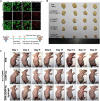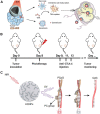Recent advances in lanthanide-doped up-conversion probes for theranostics
- PMID: 36846851
- PMCID: PMC9949555
- DOI: 10.3389/fchem.2023.1036715
Recent advances in lanthanide-doped up-conversion probes for theranostics
Abstract
Up-conversion (or anti-Stokes) luminescence refers to the phenomenon whereby materials emit high energy, short-wavelength light upon excitation at longer wavelengths. Lanthanide-doped up-conversion nanoparticles (Ln-UCNPs) are widely used in biomedicine due to their excellent physical and chemical properties such as high penetration depth, low damage threshold and light conversion ability. Here, the latest developments in the synthesis and application of Ln-UCNPs are reviewed. First, methods used to synthesize Ln-UCNPs are introduced, and four strategies for enhancing up-conversion luminescence are analyzed, followed by an overview of the applications in phototherapy, bioimaging and biosensing. Finally, the challenges and future prospects of Ln-UCNPs are summarized.
Keywords: biomedicine; lanthanide-doped; probes for theranostics; up-conversion; up-conversion luminescence.
Copyright © 2023 Xu, Li, Li, Lin and Lv.
Conflict of interest statement
The authors declare that the research was conducted in the absence of any commercial or financial relationships that could be construed as a potential conflict of interest.
Figures











Similar articles
-
Engineered lanthanide-doped upconversion nanoparticles for biosensing and bioimaging application.Mikrochim Acta. 2022 Feb 17;189(3):109. doi: 10.1007/s00604-022-05180-1. Mikrochim Acta. 2022. PMID: 35175435 Review.
-
Controlled optical characteristics of lanthanide doped upconversion nanoparticles for emerging applications.Dalton Trans. 2017 Dec 12;46(48):16729-16737. doi: 10.1039/c7dt03049e. Dalton Trans. 2017. PMID: 29125162
-
Engineering of Lanthanide-Doped Upconversion Nanoparticles for Optical Encoding.Small. 2016 Feb 17;12(7):836-52. doi: 10.1002/smll.201502722. Epub 2015 Dec 17. Small. 2016. PMID: 26681103
-
Lanthanide-Activated Nanoparticles: A Toolbox for Bioimaging, Therapeutics, and Neuromodulation.Acc Chem Res. 2020 Nov 17;53(11):2692-2704. doi: 10.1021/acs.accounts.0c00513. Epub 2020 Oct 26. Acc Chem Res. 2020. PMID: 33103883 Review.
-
Recent advances in synthesis and surface modification of lanthanide-doped upconversion nanoparticles for biomedical applications.Biotechnol Adv. 2012 Nov-Dec;30(6):1551-61. doi: 10.1016/j.biotechadv.2012.04.009. Epub 2012 Apr 27. Biotechnol Adv. 2012. PMID: 22561011 Review.
Cited by
-
Silica-coated LiYF4:Yb3+, Tm3+ upconverting nanoparticles are non-toxic and activate minor stress responses in mammalian cells.RSC Adv. 2024 Mar 14;14(13):8695-8708. doi: 10.1039/d3ra08869c. eCollection 2024 Mar 14. RSC Adv. 2024. PMID: 38495986 Free PMC article.
-
Synthesis of Highly Luminescent Silica-Coated Upconversion Nanoparticles from Lanthanide Oxides or Nitrates Using Co-Precipitation and Sol-Gel Methods.Gels. 2023 Dec 22;10(1):13. doi: 10.3390/gels10010013. Gels. 2023. PMID: 38247736 Free PMC article.
-
Enhanced brightness and photostability of dye-sensitized Nd-doped rare earth nanocomposite for in vivo NIR-IIb vascular and orthotopic tumor imaging.J Nanobiotechnology. 2025 Feb 7;23(1):91. doi: 10.1186/s12951-025-03145-z. J Nanobiotechnology. 2025. PMID: 39920730 Free PMC article.
References
-
- Adachi S. (2018). Photoluminescence properties of Mn4+-activated oxide phosphors for use in white-LED applications: A review. J. Luminescence 202, 263–281. 10.1016/j.jlumin.2018.05.053 - DOI
-
- Ali R., Saleh S. M., Meier R. J., Azab H. A., Abdelgawad I. I., Wolfbeis O. S. (2010). Upconverting nanoparticle based optical sensor for carbon dioxide. Sensors Actuators B-Chemical 150 (1), 126–131. 10.1016/j.snb.2010.07.031 - DOI
Publication types
LinkOut - more resources
Full Text Sources

